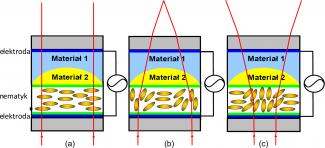The lens is an important element of the eye of mammals, birds, reptiles, amphibians, and fish. It allows one to see objects located at different distances clearly. It is possible because images are formed on the retina - another important part of the eye. Clear images are achieved by changes in the shape of the lens.
To bring objects in close proximity into focus, electric impulses from the brain transmitted via the optical nerve cause the lens to become thicker. Its spherical surfaces then become more convex. Clear images of distant objects, on the other hand, are produced by reducing the convexity. Muscles supporting the lens in the eye are involved in these changes. Consequently, the light that reflects from objects and reaches the eye is focused on the retina having passed through the lens.
With advances in technology, the ability, created by nature in the course of evolution, to control the shape of the lens is now mimicked in optical instruments. A number of conceptual designs of tunable lenses have been developed for a variety of applications. These include lenses that feature nematic liquid crystals (otherwise known as nematics – read about them in the Liquid crystal displays blog post). They are transparent liquid materials with unique optical properties. They also have another valuable characteristic: a specific way of reacting to external electric fields. Digital displays, monitor screens, TV screens, smartphone displays etc., that are such a common feature of our everyday life take advantage of this property.
Nematics are also used in areas other than the broadly defined imaging. Examples are provided by devices to control light beam parameters, e.g. direction and intensity, as well as variable-focus lenses that function like eye lenses.
The operating principle of regular glass lenses (as well as the lens in the eye), i.e. the ability to focus light, is a consequence of the spherical shape of their surface. With liquid crystal lenses, the same optical properties can be achieved not only by the spherical surfaces of the liquid crystal component, but also by appropriate modification of the optical properties of the liquid crystal layer, which is achieved by a specific electric field generated by the electrodes. More importantly, by changing the voltage applied to the electrodes, the focusing ability of the lens can be altered.
In the 40 odd years since the construction of the first liquid crystal lens, dozens of different designs have been proposed, which testifies to the ingenuity of engineers and the great potential hidden in the extraordinary materials that liquid crystals are. Depending on each individual application, different technical parameters of the lenses need to be optimized, e.g. response time and control voltage. Further lens improvement efforts involve reducing light loss, power consumption and wireless power supply, particularly relevant e.g. for corrective lenses.
Liquid crystal lenses may be found useful in augmented reality devices, smartphone cameras, webcams, miniature projection systems, holographic projectors, and even in contact lenses for vision correction. Electrical tunability offered by liquid crystal lenses, i.e. the ability to control lens enlargement electrically, is extremely attractive because movable parts of the optical system can be eliminated. Electrically tunable liquid crystal lenses are a revolutionary technology and will have a major impact on applied optics and optometry.
The figure below shows an example of a nematic lens with flat electrodes. The upper electrode and the nematic are separated by a layer made up of two transparent materials, 1 and 2, of specific shape. As a result, an electric field is generated that acts on the nematic, which, depending on the voltage between the electrodes, affects the overall focusing capacity of the system. Light is not focused unless voltage is applied - the system behaves like a regular transparent plate. Once sufficiently high voltage - in the range 10 - 90 V, is applied, the system behaves like a lens, depending on the materials used, either converging or diverging lens as shown in the ray diagrams below.






